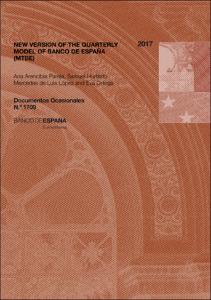New version of the Quarterly Model of Banco de España (MTBE)
Authors
Issue Date
6-Feb-2018
Physical description
29 p. : gráficos, tablas
Abstract
El Modelo Trimestral del Banco de España (MTBE) es un modelo macroeconómico de gran escala utilizado en las previsiones a medio plazo de la economía española, así como para la simulación de escenarios. El modelo está especificado como un conjunto de ecuaciones de corrección del error, y, especialmente en el corto plazo, responde principalmente a los canales de demanda. Este documento presenta una actualización del modelo, estimada con datos de 1995 a 2014. En esta iteración se ha implementado una mejora sustancial de las técnicas econométricas utilizadas en la estimación. Pese a ello, los cambios en los coeficientes y en los resultados de simulación, en comparación con la versión anterior del modelo, son menores de lo observado en actualizaciones anteriores. Comparado con el MTBE-2014, esta nueva versión (MTBE-2017) muestra una respuesta menor de la demanda a los tipos de interés y a la bolsa, pero mayor al crédito
menos respuesta del PIB a la demanda mundial, pero más a los precios mundiales y al precio del petróleo
efectos más positivos sobre output y empleo de la moderación de precios y salarios
y multiplicadores fiscales algo mayores y más rápidos para algunas medidas (consumo e inversión públicos, impuestos directos a hogares), pero menores para otras (impuestos indirectos, impuesto sobre sociedades)
The Quarterly Model of Banco de España (MTBE, Modelo Trimestral del Banco de España), is a large-scale macro-econometric model used for medium term macroeconomic forecasting of the Spanish economy, as well as for performing scenario simulations. The model is specified as a large set of error correction equations, and, especially in the short run, is mostly demand driven. This paper presents an update of the model, estimated with data from 1995 to 2014. In this iteration, a big revamp to the econometric techniques used in estimation has been implemented. Despite that, changes in coefficients and simulation results with respect to the previous version of the model are smaller than what we saw in earlier updates. Compared with MTBE-2014, this new version (MTBE-2017) shows less response of demand to interest rates and stock market prices but more to credit, less response of GDP to world demand but more to world prices and to the price of oil, more positive effects to output and employment from price and wage moderation, and slightly faster and bigger fi scal multipliers for some shocks (government consumption and investment, direct taxes to households) but smaller for others (indirect taxes, direct taxes to firms)
menos respuesta del PIB a la demanda mundial, pero más a los precios mundiales y al precio del petróleo
efectos más positivos sobre output y empleo de la moderación de precios y salarios
y multiplicadores fiscales algo mayores y más rápidos para algunas medidas (consumo e inversión públicos, impuestos directos a hogares), pero menores para otras (impuestos indirectos, impuesto sobre sociedades)
The Quarterly Model of Banco de España (MTBE, Modelo Trimestral del Banco de España), is a large-scale macro-econometric model used for medium term macroeconomic forecasting of the Spanish economy, as well as for performing scenario simulations. The model is specified as a large set of error correction equations, and, especially in the short run, is mostly demand driven. This paper presents an update of the model, estimated with data from 1995 to 2014. In this iteration, a big revamp to the econometric techniques used in estimation has been implemented. Despite that, changes in coefficients and simulation results with respect to the previous version of the model are smaller than what we saw in earlier updates. Compared with MTBE-2014, this new version (MTBE-2017) shows less response of demand to interest rates and stock market prices but more to credit, less response of GDP to world demand but more to world prices and to the price of oil, more positive effects to output and employment from price and wage moderation, and slightly faster and bigger fi scal multipliers for some shocks (government consumption and investment, direct taxes to households) but smaller for others (indirect taxes, direct taxes to firms)
Publish on
Documentos Ocasionales / Banco de España, 1709
Subjects
Economía española; Modelo macroeconométrico; Spanish economy; Macroeconometric model; Modelización econométrica; Modelos econométricos; España
Appears in Collections:












